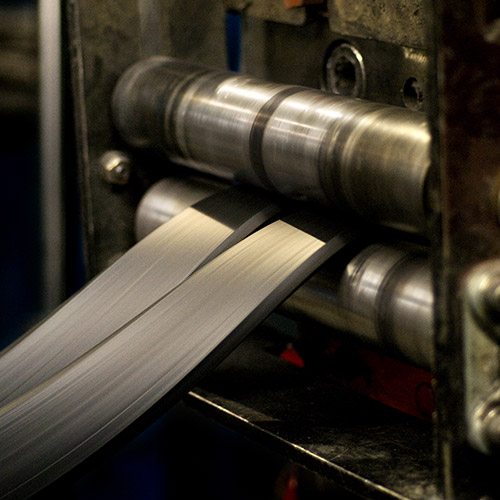we understand Customer Processes
Multiple manufacturing processes exist. Each process has characteristics that make it the ideal choice for manufacturing certain types of products. The manufacturing process affects the compounding. The most common rubber manufacturing processes are extrusion, compression molding, injection molding and calendaring.

Extrusion
Rubber extrusion is perfect choice to manufacture articles like seals, tubes, rods, and cable insulations or sheaths.
High throughput required by modern extrusion manufacturer is achieved with perfect balance of cure speed and flow properties.
Hexpol works continuously and intensively to select the correct polymers for extrusion processes according to molecular structure and reactivity. This knowledge allows to provide cost effective and reliable solutions for high speed extrusion.
Lots of applications such complex automotive sealing systems, building and constructions or industrial sealings require more and more profiles with complex geometry to meet the requirements of engineers and designers. Compounds from Hexpol allow for precise control of shape and dimensional stability trough accurate tuning of green strength and die swell of compounds preventing collapses, surging, and distortions.
High surface quality required by automotive or aesthetic applications is obtained by optimized mixing and dispersion, selection of best compound straining technics and optimized rheology. This expertise guarantees profiles with smooth surface avoiding typical defects like orange peel, pimples and bubbles.
Injection Molding
Injection moulding is ideal moulding technique when large-volume serial manufacturing is required. Injection moulding affords high quality part with high efficiency and short cycle times thanks to preheating of compound during the plastification and flow throughout channels to the mould cavities.
Mixing compounds for injection moulding requires a precise control of viscosity and reactivity. Cure speed is balanced to guarantee mould filling and minimize curing time. This is even more true today, with modern moulds designed to maximize number of parts per shot and minimize wastes due to flashes and sprues.
Nowadays, automotive, aerospace, and oil & gas industries do not tolerate any failure due to leakage of fuels, oils, and fluids distribution circuits. This is possible only trough high reproducibility of mixing and high consistency of properties of cured parts affording durable sealing properties. Careful and continuous selection of raw materials allows for obtaining compounds with enhanced thermal and chemical stability that these markets pursuit.
Precise dosage and accurate choice of process-aids, accelerants, stabilizers, reduce mould fouling and minimize mould maintenance and blooming on parts.
Compression molding
Compression moulding is still popular manufacturing method of rubber goods due to easiness and versatility. Although compression moulding affords the least control of tolerance, any part with any size is virtually possible as long as clamp force is sufficient. Often, compounds need to be preformed before being moulded, to decrease waste and increase dimension stability.
Compounds for compression moulding need viscosity and plasticity suitable to little shear process, and fast cure speed to minimize cycles.
By compression moulding, the highest hardness parts are affordable, enabling the use of the most reinforcing fillers.
When compression moulding is used to make big parts, precise control of lubricants and releasing agents is needed to avoid part ruptures when clamp force is released.
Transfer molding
Transfer moulding is an evolution of compression moulding with enhanced precision. Rubber is placed in a reservoir pot on the mould and then distributed into several cavities trough channels.
Compounds for transfer moulding combine low viscosity necessary to fill mould cavities and reduce clamp pressure with high cure speed. Indeed, transfer moulding is still little shear process and curing occurs only by thermal exchange of material with mould plates.
Calendaring
Calendering is an important industrial process where a rubber compound is formed to a continuous sheet or coated on a fabric. This is accomplished by forcing rubber compounds trough different roll gaps.
Calendering is essential process for the manufacturing of tyres, conveyor belts, sheets and hoses.
Compounds for calendering require extremely control over viscosity and green strength of compound to guarantee thickness stability. Proper selection of polymer architecture is thus fundamental for smooth processing. Dimensional stability of calendered compounds is also influenced and desired to avoid distortions upon storage.
Precise control over curing is also requested, especially when multi-layered structures are formed by overlapping of different calendered materials, to avoid again distortions.
Adhesion to fabrics is obtained by addition of proper ingredients such as primers or resins and by use of selected non-interfering process aids.
High surface quality is often requested in industrial process using calendered rubber compounds like offset printing. Extreme control over process mixing and appropriate selection of raw material purity is crucial.
Contact our global experts
To learn more about how we can make a material difference in your business, contact our skilled staff representatives for more detailed information.


